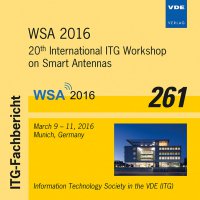Practical Aspects of Compress and Forward with BICM in the 3-Node Relay Channel
Conference: WSA 2016 - 20th International ITG Workshop on Smart Antennas
03/09/2016 - 03/11/2016 at München, Deutschland
Proceedings: WSA 2016
Pages: 7Language: englishTyp: PDF
Personal VDE Members are entitled to a 10% discount on this title
Authors:
Kern, Daniel; Kuehn, Volker (Institute of Communications Engineering, University of Rostock, Germany)
Abstract:
The classical relay channel is well investigated in literature. The most common relaying techniques are Decode-and-Forward (DF) and Compress-and-Forward (CF), whereby the achievable rates of these techniques outperform each other depending on the quality of the links between nodes. Based on the results from information theory assuming Gaussian codebooks, this paper focuses on practical aspects of the CF relay protocol which outperforms DF if the source-relay link becomes the bottleneck of the system. In practice, appropriate quantizers have to be found whose output can be exploited by real decoders. As the relay’s receive signal contains also noise, maximum entropy quantizers are unrewarding. Therefore, the Information Bottleneck (IB) method is used to find the optimal quantizer for a specific scenario. Furthermore, it is a priori not clear whether signal processing before quantizing the received signal is useful considering coded modulation with iterative decoders. In a nutshell, the received signals may be either quantized directly, or after a few iterations of decoding. For either case, it is shown how the respective quantization indices are optimally exploited by a joint decoder at the destination. Results reveal that performing soft-output decoding at the relay prior to quantization can be slightly rewarding in some cases. In general however, the gain justifies not the additional decoding effort at the relay.


